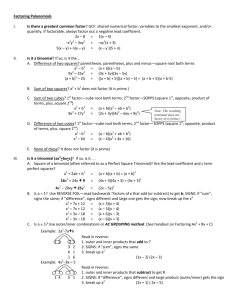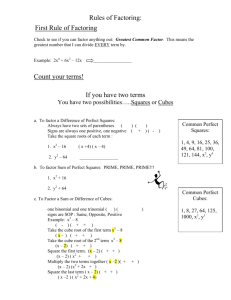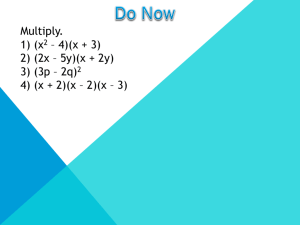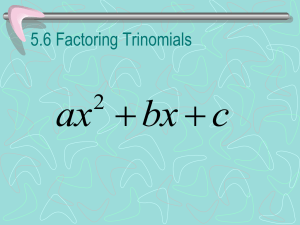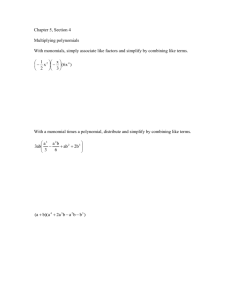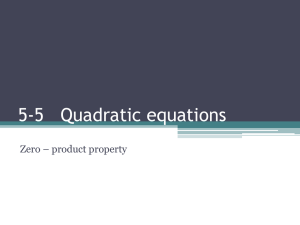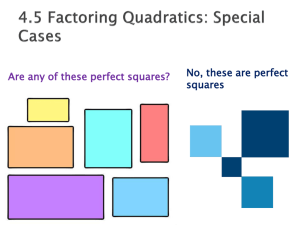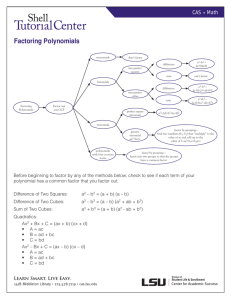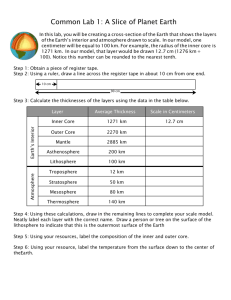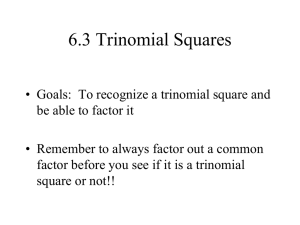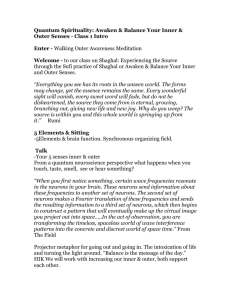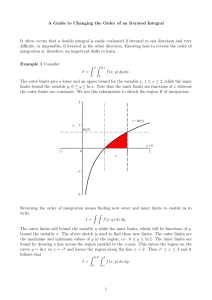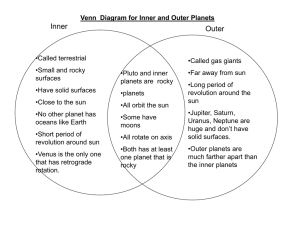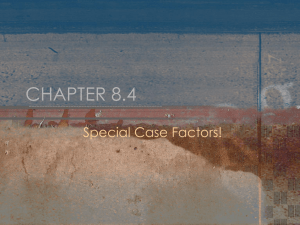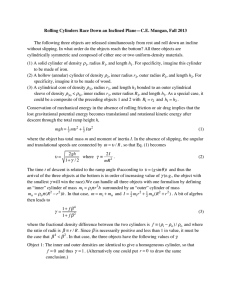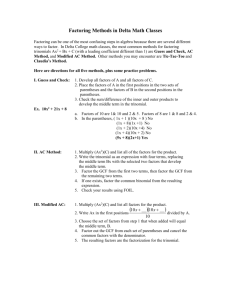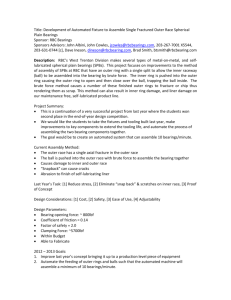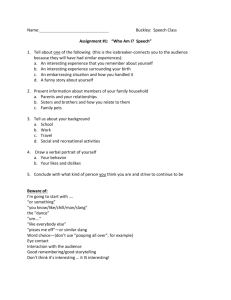x 2 (x – 3) + 2(x – 3)
advertisement
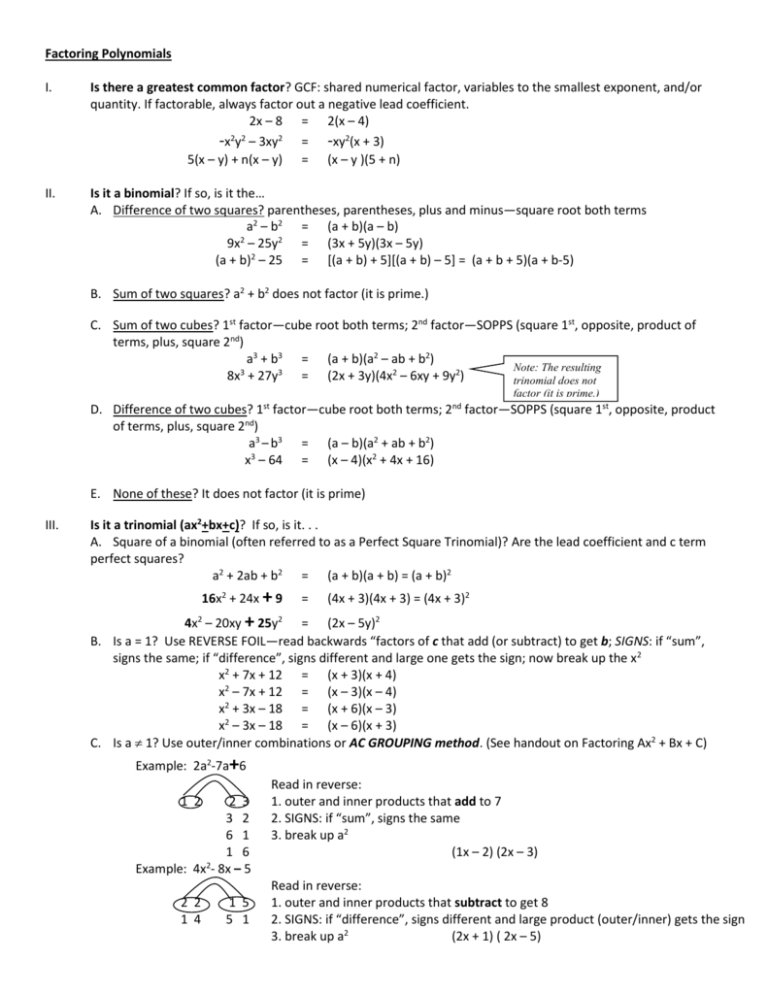
Factoring Polynomials I. Is there a greatest common factor? GCF: shared numerical factor, variables to the smallest exponent, and/or quantity. If factorable, always factor out a negative lead coefficient. 2x – 8 = 2(x – 4) 2 2 -x y – 3xy2 = -xy2(x + 3) 5(x – y) + n(x – y) = (x – y )(5 + n) II. Is it a binomial? If so, is it the… A. Difference of two squares? parentheses, parentheses, plus and minus—square root both terms a2 – b2 = (a + b)(a – b) 2 9x – 25y2 = (3x + 5y)(3x – 5y) (a + b)2 – 25 = [(a + b) + 5][(a + b) – 5] = (a + b + 5)(a + b-5) B. Sum of two squares? a2 + b2 does not factor (it is prime.) C. Sum of two cubes? 1st factor—cube root both terms; 2nd factor—SOPPS (square 1st, opposite, product of terms, plus, square 2nd) a3 + b3 = (a + b)(a2 – ab + b2) Note: The resulting 3 8x + 27y3 = (2x + 3y)(4x2 – 6xy + 9y2) trinomial does not factor (it is prime.) D. Difference of two cubes? 1st factor—cube root both terms; 2nd factor—SOPPS (square 1st, opposite, product of terms, plus, square 2nd) a3 – b3 = (a – b)(a2 + ab + b2) x3 – 64 = (x – 4)(x2 + 4x + 16) E. None of these? It does not factor (it is prime) III. Is it a trinomial (ax2+bx+c)? If so, is it. . . A. Square of a binomial (often referred to as a Perfect Square Trinomial)? Are the lead coefficient and c term perfect squares? a2 + 2ab + b2 = (a + b)(a + b) = (a + b)2 16x2 + 24x + 9 = (4x + 3)(4x + 3) = (4x + 3)2 4x2 – 20xy + 25y2 = (2x – 5y)2 B. Is a = 1? Use REVERSE FOIL—read backwards “factors of c that add (or subtract) to get b; SIGNS: if “sum”, signs the same; if “difference”, signs different and large one gets the sign; now break up the x2 x2 + 7x + 12 = (x + 3)(x + 4) x2 – 7x + 12 = (x – 3)(x – 4) x2 + 3x – 18 = (x + 6)(x – 3) x2 – 3x – 18 = (x – 6)(x + 3) C. Is a 1? Use outer/inner combinations or AC GROUPING method. (See handout on Factoring Ax2 + Bx + C) Example: 2a2-7a+6 1 2 2 3 3 2 6 1 1 6 2 Example: 4x - 8x – 5 2 2 1 4 1 5 5 1 Read in reverse: 1. outer and inner products that add to 7 2. SIGNS: if “sum”, signs the same 3. break up a2 (1x – 2) (2x – 3) Read in reverse: 1. outer and inner products that subtract to get 8 2. SIGNS: if “difference”, signs different and large product (outer/inner) gets the sign 3. break up a2 (2x + 1) ( 2x – 5) AC GROUPING method Example: 2a2-7a+6 AC=2 * 6 = 12….factors of 12 that add to get -7 12 -7 12 1 2 6 3 4 -3 -4 (would add to -7) 2 3 2 3 (like number-pattern so factor by grouping) 2a2 - 3a - 4a + 6 IV. Does it have four terms. If so, will it. . . A. Group (first two terms together, last two terms together…look for a number pattern) 5/5 5/5 1 1 1 1 1 1 5ax – 5bx + a – b 1 3 3 1 2 = = = (5ax – 5bx) + (a – b) 5x (a – b) + 1(a – b) (a – b)(5x + 1) 3 = (x3 – 3x2) + (2x – 6) = x2(x – 3) + 2(x – 3) = (x – 3)(x2 + 2) B. Group (first three terms together) x2 + 6x + 9 – y2 = (x2 + 6x + 9) – y2 = (x + 3)2 – y2 = [(x + 3) + y][(x + 3) – y] C. Group (last three terms together) y2 – x2 + 6x – 9 = y2 – (x2 – 6x + 9) = y2 – (x – 3)2 = [y + (x – 3)][y – (x – 3)] BE SURE YOU ANSWER WON’T FACTOR FURTHER. x – 3x + 2x – 6
